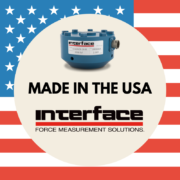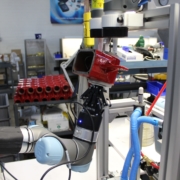Conveyor Belts Use Load Cells to Keep Things Moving
 Conveyor belts are incredibly versatile machines with numerous applications across industries, constantly moving materials from one point to another. During some of the busiest packaging and shipment times of the year, it is a good reminder of why measurement solutions keep things moving fast and efficiently.
Conveyor belts are incredibly versatile machines with numerous applications across industries, constantly moving materials from one point to another. During some of the busiest packaging and shipment times of the year, it is a good reminder of why measurement solutions keep things moving fast and efficiently.
Critical for automated manufacturing, conveyor belts rely on precise weight distribution, timing, and speed of the conveyor belt operation to keep production in sync.
Conveyors are used for sorting and merging systems, inspection systems, and automated loading and unloading using robotic arms or other equipment to handle materials efficiently. Their versatility and adaptability make them critical in modernizing industries, including construction, mining, manufacturing, logistics, maritime, and agriculture.
Boxes, cans, bottles, and other packages glide smoothly through packaging lines on conveyor belts, ensuring efficient sorting, labeling, and palletizing. These machines efficiently load and unload ships, trucks, and trains with bulk materials, minimizing manual labor and maximizing throughput. Conveyor belts are crucial in sorting and distributing packages in warehouses and postal facilities, speeding up delivery processes.
It is also important to recognize how specialized conveyor belts transport people in public spaces. Conveyor belts seamlessly whisk luggage from check-in counters to aircraft and vice versa, ensuring a smooth passenger experience.
Force measurement can be applied to testing and monitoring conveyor belts in several ways. One of the most common ways is by using load cells to measure the alignment of the belt. Load cells can detect subtle changes in belt behavior, such as uneven loading or misalignment, which can indicate internal damage like cracks or tears. Early identification of these issues allows for timely interventions, preventing further damage and costly repairs.
Testing the conveyor belt rotation or ability to hold weight is a requirement for equipment makers and engineers. Machine builders use Interface sensors in the design of conveyors. In addition to monitoring the system during peak usage, load cells are instrumental in testing the equipment’s quality and durability.
Load cells on the head and tail pulley shafts continuously monitor belt tension for preventative maintenance. This data helps identify deviations from optimal tension levels, leading to premature belt wear, pulley misalignment, and energy inefficiency. You can prevent costly repairs and downtime by addressing these issues early on.
Conveyor systems often have multiple belts working in tandem. Load cells can monitor the load distribution across these belts, ensuring balanced operation and preventing the overloading of individual components.
Conveyor Belt Adhesion Test
A customer wanted to test the adhesion strength between a conveyor belt’s many layers and textiles. They wanted to conduct a separation test from the rubber of the conveyor belt from the other layers. They also wanted a wireless solution. Interface suggested a SMA Miniature S-Type Load Cell to be installed in the customer’s tensile test load frame, where it measured the forces applied as the test was conducted and the layers were pulled and separated. When connected to the WTS-AM-1F Wireless Strain Bridge Transmitter Module, the data was wirelessly transmitted to WTS-BS-5 Wireless Analog Output Receiver. The WTS-BS-5 then connected to the 9330 Battery Powered High Speed Data Logging Indicator to display, graph, and log the data with the supplied BlueDAQ software. With Interface’s force measurement system and solution, the customer successfully tested the strength of the adhesion applied to their conveyor belts through the layer separation test.
Force measurement sensors can be built into machines as a real-time monitoring system. This type of force application can let engineers know if there is a problem with the system that needs to be taken down for repairs by reviewing data and seeing discrepancies in the normal forces on the conveyor belt. This is particularly important in maintaining efficiency on production lines to ensure minimal downtown.
Food And Beverage Conveyor Belt
Conveyor belts for the food and beverage industry must be maintained and properly aligned to transport products. A load cell is needed to prevent misalignment and to reduce the risk of damage or malfunction of the belt while in operation. Interface suggested installing PBLC Pillow Block Load Bearing Load Cells onto the conveyor belt. They are designed for easy maintenance. The PBLCs measured and monitored the force of the conveyor belt while preventing misalignment. The PBLC Pillow Block Load Cells successfully maintained the proper alignment of the conveyor belt for the food and beverages being transported while also monitoring the forces being implemented.
In automotive, electronics, and other production settings, conveyor belts move components and products along the assembly line, facilitating efficient workflow and ensuring precise positioning.
Conveyor belts easily handle diverse materials, from transporting heavy metal sheets in steel mills to delicate circuit boards in electronics factories. They are the go-to for transporting vast quantities of mined ores, coal, grains, and other bulk materials over long distances and uneven terrain.
Conveyor belts move waste and recyclables efficiently in processing facilities, ensuring efficient sorting and processing. Industrial automation robotics often supports this as part of advanced conveyor systems.
Automating Conveyor Production Lines
Collaborative robots, known as cobots, are used to working alongside humans next to conveyor belts on the production line. Extensive safety measures must be taken for the conveyor and the robot for optimal efficiency and operations. A multi-axis sensor is a tool for this use case. The 6A40 6-Axis Load Cell is installed at the head of the cobot. The 6A40 6-Axis Load Cell interfaces with the BX8-HD44 BlueDAQ Series Data Acquisition System for data collection of force and torque measurements on the line. The customer connected the BX8’s analog outputs to their control system. As a result, the customer can log, display, and graph these measurements during the robot and belt operations. The results are sent to the customer’s control system via analog or digital output.
Interface products are commonplace in these types of applications. Force measurement is integral to advanced manufacturing systems like conveyor belts. Our sensors are utilized to ensure accuracy and repeatability throughout the production line.
We understand manufacturing test and measurement applications, and our custom OEM solutions are ideal for manufacturers who require direct installation to monitor weight, force, and torque into conveyor belt systems. Contact our application experts to see how we can help you modernize your conveyor systems with advanced sensor technologies.
ADDITIONAL RESOURCES
Interface Solutions for Heavy Equipment
Interface Solutions for Production Line Engineers
Examining Machine Builder Applications








